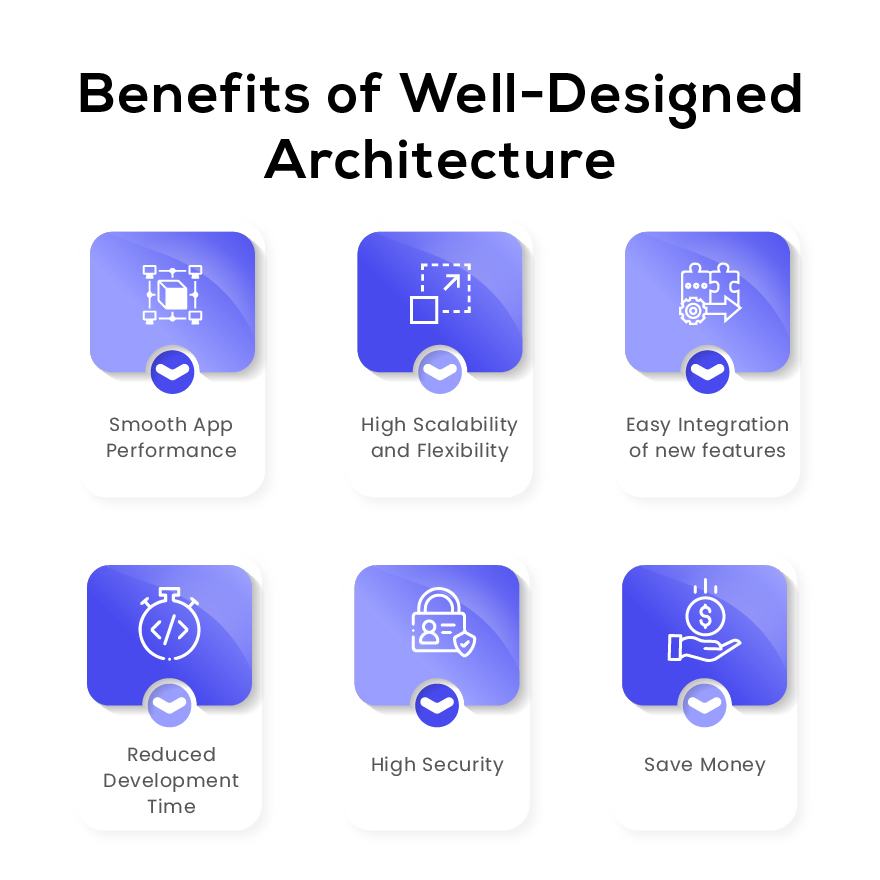As technology continues to evolve and new tools become available, businesses are looking for ways to stay up to date with the trends by investing in the tools that give businesses an edge over the competition in the ever-evolving market landscape.
While there are alternative methods for optimizing processes in other industries, application architecture serves the same objective in the software development industry. Especially in a market where speed is the top priority, delaying a project because your processes can’t adjust to customer needs might be a death sentence, which is why having a clear and flexible application architecture is vital.
Foreseeing the trends, there will be a continued emphasis on developing cloud-based applications and increased use of AI/ML technologies. As such, having a well-thought-out application architecture tailored to the business' needs that can adapt to changing technologies is essential for creating a successful and sustainable development environment.
In addition, microservices, containers, and serverless architectures will become more commonplace as businesses look to maximize their development efficiency and reduce costs. So, by taking the time to ensure that an application architecture is correctly implemented and managed, companies can reduce the cost of development and deployment while improving the performance and reliability of their applications.
This blog post will explore why application architecture is crucial to your business and how it can help your business succeed.
What is Application Architecture
Application architecture is a structure that defines the interactions between software components. It is an integral part of software development and design that defines how an application should be built, implemented and deployed. Application architecture is vital in creating any software product, as it sets the guidelines for how components are organized and connected.
It helps developers plan out the different stages of their software projects so that the product meets its intended objectives. The application architecture also sets the rules for software components regarding functionality, data flows, and security.
An effective application architecture helps to ensure that the desired quality, performance, and scalability are achieved throughout the entire development process.
Application architecture can be broken down into three distinct areas.
- The logical architecture defines how the system interacts with users and data sources.
- The physical architecture which defines where components are located and how they are connected.
- The deployment architecture defines the system's deployment on hardware and software platforms.
What are the types of Applications Architecture
We know that application architecture is designing and developing a software system. It defines the structure, behavior, and design of the application.
There are several types of application architectures that have become popular in recent years.
Monolith Architecture:
Monolith application architecture is a traditional approach to software development that focuses on a single, cohesive application built as a single unit. It is a single-tiered architecture in which all components of the application, such as the database, user interface, business logic, and other application components, are built into one package.
Example: Online banking is a monolith application architecture. The platform would include a single database, a single user interface, business logic, and application components. This architecture allows developers to create a single, easy-to-update application on a safe, dependable platform.
Microservices Architecture:
A microservices architecture is an approach to developing an application as a suite of modular components or services. The idea behind this architecture is to break down the entire application into smaller parts, making it easier to maintain and update.
Each service is responsible for a single functionality and has a unique set of data stores and APIs. The advantage of this architecture is that it allows for faster deployment, easier scalability, and improved fault tolerance.
Example: Netflix is among the pioneers of the microservices space. Netflix uses a microservices architecture to allow for the rapid development and deployment of new features while maintaining high scalability and reliability.
Microservices architecture enables Netflix to segregate its services, such as movie search, user profiles, and payment processing, into separate services, allowing faster development cycles and quick adaptability to changing customer needs.
Cloud Native Architecture:
Cloud-native architecture is a style of application development that takes advantage of the benefits of cloud computing. This type of architecture focuses on building applications in a modular way, using technologies such as containers, serverless functions, and Infrastructure-as-a-Service (IaaS) offerings. This architecture aims to make applications more resilient and easier to manage.
Example: Google Cloud Platform's App Engine is a platform-as-a-service (PaaS) that enables developers to build and host web applications in the cloud with no need for servers or infrastructure management It is a great example of how cloud-native architectures can be used to quickly develop and deploy applications.
Event-Driven Serverless Architecture:
Event-driven serverless architecture is an approach to developing applications that use cloud resources to respond to events in real time. This architecture relies on serverless technologies such as AWS Lambda or Azure Functions to execute code in response to events without requiring the developer to manage any underlying infrastructure.
Example: AWS Lambda is a serverless compute service that runs code in response to events and automatically manages the underlying compute resources. It supports a variety of programming languages and can be used to build applications that span from simple scripts to complex applications.
Service-Oriented Architecture
Service-oriented architecture (SOA) is a software architectural style that promotes the loose coupling of services with well-defined interfaces. It enables communication between different systems, platforms, and languages by utilizing services such as web services and APIs. SOA helps improve the scalability, flexibility, and maintainability of software applications by allowing them to be broken down into discrete, reusable services.
Example: Online retail is an example of Service Oriented Architecture. This architecture allows each component to function independently, such as the shopping cart, payment system, product search engine, and product catalogue. Each of these components can communicate with the others through web services, allowing them to access and share data and functionality.
The Benefits of a Good Application Architecture
The benefits of having a good application architecture are numerous. Application architectures that are designed properly can save companies time, money, and resources while providing better user experiences.
Scalability: For starters, a well-designed application architecture will ensure that applications can scale to meet the needs of a growing user base. When developing an application, it is important to ensure that the system can handle increased traffic and load times without crashing or slowing down. A good application architecture ensures the system can do this without needing constant redesigns and upgrades.
Security: A well-designed and implemented application architecture provide greater security for users. By creating a secure environment in which user data is stored, users can feel more confident that their information is safe. This reduces the risk of data breaches and ensures that user data is protected against malicious attacks and unauthorized access.
Performance: Application architectures can highly improve the overall performance of applications. By ensuring that the right technologies are used and deployed in the right places, applications can run faster, smoother, and with fewer errors. This, in turn, makes the user experience more enjoyable and efficient.
Adaptability: Finally, good application architecture enables applications to be adapted easily. As business requirements change, a good application architecture allows developers to make changes quickly without completely redesigning the entire system. This reduces downtime and keeps development costs low.

How to Implement an Effective Application Architecture
If you're looking to get the most out of your applications, it's important to understand how to implement application architecture effectively. Good architecture can make all the difference when it comes to the success of your applications. Here are some tips on how to successfully implement an effective application architecture.
Start with Design Principles
To ensure your application architecture is successful, you should define a set of design principles. These principles form the foundation of your design and serve as a guide throughout the development process.
Keep Your System Flexible
Your application architecture should be designed with flexibility. This means that your system should be designed in such a way that allows for change over time.
Implement Scalability
As your application grows, you must ensure that it can handle increased loads. Therefore, when designing your application architecture, it's important to consider scalability. This means that your system should be able to accommodate additional hardware resources without making major changes to the underlying architecture.
Utilize Automation
Automation can help reduce the amount of manual work required to maintain and manage your applications. Automation can be used to automate tasks such as deployment, scaling, and monitoring, which will save you time and resources in the long run.
Monitor Your System
To establish your system is running optimally, you should continuously monitor its performance. Monitoring will give you visibility into your system's performance and allow you to identify and address any potential issues before they become a problem.
With a well-designed and efficient architecture in place, you'll be able to maximize the value of your applications and ensure their success.
Conclusion
Application architecture is an essential part of creating a successful application. It provides the foundation and infrastructure that helps you to build the best solutions for your business. A well-architected application can help to improve performance, scalability, and security. It also ensures the code is efficient and maintainable in the long term.
With the right application architecture, businesses can build robust and reliable solutions to handle future requirements. Therefore, understanding the importance of application architecture and how to implement it effectively is critical for any organization that wants to create effective applications.
Looking forward to investing in the application architecture for your development processes? Aspired provides experienced application architects to optimize your processes to success. Join forces with Aspired to hire the top-rated remote resource today!

 Clients
Clients
 Processes
Processes
 Blog
Blog










